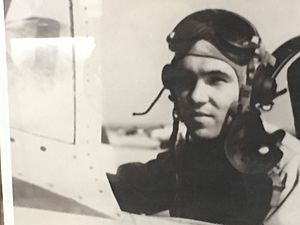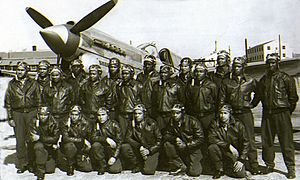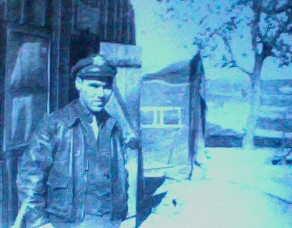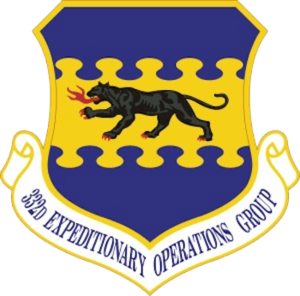Marion Rodgers facts for kids
Marion Raymond "Rodge" Rodgers was a brave American pilot who served in the Air Force. He was a member of the famous Tuskegee Airmen. This special group was made up of the first African-American military pilots in the United States armed forces. They fought heroically in World War II. Rodgers reached the rank of Lieutenant Colonel and served for 22 years. After his combat missions, he commanded the well-known 99th Flying Squadron, also called the "Red Tails." Later, he worked in management for NORAD and NASA. Even in his nineties, Rodgers was one of the last Tuskegee Airmen still alive. He often shared his amazing experiences and was honored at many public events.
Contents
Growing Up and Dreams of Flying
Rodgers was born in Detroit, Michigan, on September 23, 1921. For his early years, he lived with his mother in Dublin, Laurens County, Georgia. His interest in flying started when he moved to Roselle, New Jersey. There, he watched repairmen fix a damaged biplane in a car showroom garage. When the airplane finally flew, Rodgers said, "I was hooked!"
Flying High in World War II
When World War II began, the military announced a program for African-Americans to train as pilots. At that time, the American military was still separated by race. Rodgers, who had finished high school, applied for the program. He was chosen but couldn't start flight training right away. The Tuskegee Institute didn't have enough money to support all the chosen students. So, Rodgers first served in the Army's anti-aircraft artillery for about three months. He was a Radar Operator, helping guide shells to hit enemy planes. His basic training happened at Keesler Field in Mississippi.
His first flight training was in PT-17 Stearman Biplanes at Moton Field in Tuskegee, Alabama. Charles “Chief” Anderson was the instructor for all the black pilots. After this, the trainees went to Tuskegee Army Air Field. There, they flew the Vultee BT-13A for 80 hours in what was called basic training. The PT-17 was easy to land, but the new training challenged pilots with acrobatics and navigation. For the next two months, they flew the AT-6. This plane was harder to land. Rodgers finished his training in February 1944. He later said, "I made it, somehow, and was very proud." He noted that the program was segregated, but most of his white instructors were fair.
Brave Missions in the Sky
During the war, Rodgers flew 69 missions for the Army Air Force. He described his most exciting missions as "strafing missions." These were attacks where planes flew low and shot at targets on the ground. He flew these missions in Southern France, Romania, Hungary, and Germany. The Tuskegee Airmen destroyed enemy aircraft, trains, fuel dumps, and even radar stations. Their planes flew very fast, sometimes up to 600 miles per hour.
Rodgers talked about a mission on August 12, 1944, in Southern France. He was part of the 332nd Fighter Group. He said, "It was my first strafing mission." His group flew high, then dove down towards radar stations. He felt nervous at first, but when he started his dive, he became completely focused. He had to work hard to pull his plane out of the fast dive as the ground rushed up. He fired his guns for two seconds, then quickly flew out to sea. When he returned to base, he learned that two planes from his flight of eight were lost.
On another mission on December 3, 1944, Rodgers successfully crash landed his plane at the Ramitelli airbase in Italy. After the Korean War, Rodgers became a B29 bomber pilot. He also helped train South Korean military personnel.
Life After the War
After World War II, Rodgers was the last commander of the 99th Squadron. He was assigned this role by William A. Campbell. This was before the racial integration of the Air Force in 1948, when the squadron was deactivated. After serving 22 years in the Air Force, he worked in communications for NORAD and NASA.
When the movie Red Tails came out in January 2012, Rodgers took part in several celebration events. He told the Denver Post that the airstrips shown in the film were much nicer than the real ones they used. At age 93, Rodgers got to fly in a P-51 plane again. This was thanks to the "Wish of a Lifetime" Foundation. Marion Raymond Rodgers passed away on December 5, 2017. He was buried next to his son in Colorado Springs, Colorado. A special flyover of P-51 planes honored him.
Honors and Awards
For his brave actions during World War II, Rodgers received the Distinguished Flying Cross. In 2007, the Tuskegee Airmen were all given a Congressional Gold Medal at the U.S. Capitol. Rodgers was invited but chose not to go because he wanted to stay with his wife, Suzanne T., who had diabetes.
He did receive his medal later. Senator Mark Udall of Colorado congratulated Rodgers and the other eight airmen from Colorado in a speech. Rodgers is also honored at the Denver International Airport. There is a permanent exhibit with a large photo and his biography. The Georgia State Assembly named a road intersection in Laurens County after him and two other Tuskegee Airmen. In 2014, the Non-Commissioned Officers Association gave Rodgers a World War II legacy medallion.






